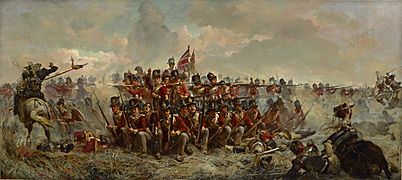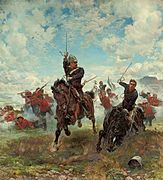Elizabeth Thompson facts for kids
Quick facts for kids
Elizabeth Thompson
|
|
|---|---|
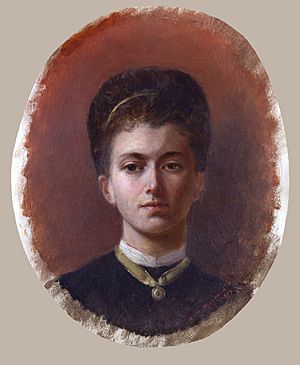
Self-portrait, 1869
|
|
| Born |
Elizabeth Southerden Thompson
3 November 1846 Lausanne, Switzerland
|
| Died | 2 October 1933 (aged 86) Gormanston Castle, County Meath, Ireland
|
| Nationality | British |
| Known for | Painting |
|
Notable work
|
The Roll Call, 1874 The 28th Regiment at Quatre Bras, 1875 The Defence of Rorke's Drift, 1880 Scotland Forever!, 1881 |
| Movement | History painting, military art |
| Title | Lady Butler |
| Spouse(s) | Sir William Butler |
| Children | 6 |
Elizabeth Southerden Thompson (born November 3, 1846 – died October 2, 1933) was a famous British painter. She was also known as Lady Butler. She was special because she painted exciting scenes from British military battles. Her paintings showed important events from wars like the Crimean War and the Napoleonic Wars.
Some of her most famous paintings include The Roll Call, which Queen Victoria herself bought! Other well-known works are The Defence of Rorke's Drift and Scotland Forever!. This last painting shows the brave Scots Greys soldiers at the Battle of Waterloo. Elizabeth once wrote that she didn't paint to make war look glorious. Instead, she wanted to show the sad parts and the bravery of the soldiers. She was married to a British Army officer, Sir William Butler. When he became a knight, she became known as Lady Butler.
Contents
Early Life and Learning to Paint
Elizabeth Butler was born in Lausanne, Switzerland. Her father was Thomas James Thompson, and her mother was Christiana Weller. Her sister, Alice Meynell, grew up to be a well-known writer and poet.
Elizabeth started learning art in 1862 when she was growing up in Italy. In 1866, she joined the Female School of Art in South Kensington, London. Even as a student, she started showing her artwork, mostly paintings done with watercolours. In 1867, one of her watercolour paintings, Bavarian Artillery Going into Action, was shown at the Dudley Gallery. This gallery was a popular place for women artists to display their work. That same year, she also showed an oil painting called Horses in Sunshine.
In 1869, her family moved to Florence, Italy, and they all became Roman Catholic. While in Florence, she studied at the Accademia di Belle Arti di Firenze, a famous art school. She learned from an artist named Giuseppe Bellucci. Elizabeth signed her paintings in different ways, like E.B., Elizth. Thompson, or Mimi Thompson. "Mimi" was her childhood nickname.
Becoming a Famous Artist
At first, Elizabeth focused on religious paintings, like The Magnificat (1872). But when she visited Paris in 1870, she saw battle scenes painted by artists like Jean Louis Ernest Meissonier. This inspired her to change her focus to war paintings.
Her painting Missing (1873) was a scene from the Franco-Prussian War. It showed the suffering and bravery of ordinary soldiers. This painting was her first one accepted by the Royal Academy of Arts in London.
In 1874, her painting The Roll Call was shown at the Royal Academy's Summer Exhibition. This painting showed tired soldiers after a battle. It became incredibly popular! So many people came to see it that a policeman had to stand next to it to control the crowds. Elizabeth later wrote that she woke up famous the day after the exhibition opened.
Her fame grew as her paintings traveled around Europe. People were surprised that a young and pretty woman was painting such powerful battle scenes. This was unusual for the time. Her popularity also grew because people in the Victorian era were very proud of the growing British Empire.
Even though her paintings showed the romance of war, they were also very realistic. She showed details like confusion, mud, and tired soldiers. Her works usually focused on British soldiers in action, but she avoided showing hand-to-hand fighting. She often showed how the soldiers might have looked to their enemies, but she didn't show many of the enemies themselves.
In 1879, Elizabeth almost became the first woman elected as an Associate Member of the Royal Academy. She missed it by only two votes!
After she married William Francis Butler in 1877, she traveled a lot. Her husband was a respected officer in the British Army. They traveled to many parts of the British Empire, and she raised their six children. Elizabeth also drew black and white pictures for books, including poems by her sister, Alice Meynell. Her work was also shown at the 1893 World's Columbian Exposition in Chicago.
Later Life and Legacy
When her husband retired from the army, they moved to Bansha Castle in County Tipperary, Ireland. She continued to show her paintings at the Royal Hibernian Academy starting in 1892.
Elizabeth had painted many watercolours while she was with her husband in Mandatory Palestine. She took these paintings with her to County Tipperary. During the Irish Civil War, they were moved to her daughter's home at Gormanston Castle for safety. Sadly, most of them were later destroyed by German bombs in London during World War II.
Lady Butler's husband passed away in 1910. She continued to live at Bansha until 1922. Then, she moved to Gormanston Castle to live with her youngest daughter, Eileen. She died there shortly before her 87th birthday and was buried in a nearby graveyard.
Elizabeth Thompson Butler was included in a special art show in 2018 called Women in Paris 1850–1900.
Famous Paintings

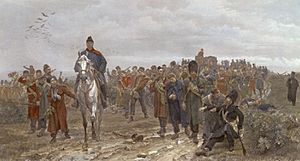
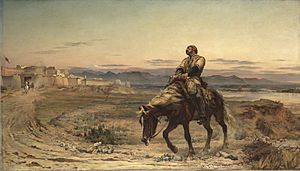

Here are some of Elizabeth Butler's well-known paintings:
- The Magnificat (1872)
- Missing (1873)
- Calling the Roll After An Engagement, Crimea (also known as The Roll Call) (1874) – This painting is owned by the Queen and is at Buckingham Palace.
- Missed (1874)
- The 28th Regiment at Quatre Bras (1875) – This painting is in Melbourne, Australia.
- Balaclava (1876) – Located at the City of Manchester Art Gallery.
- The Return from Inkerman (1877) – At Ferens Art Gallery, Kingston upon Hull.
- Remnants of an Army (1879) – Displayed at the Somerset Military Museum, Taunton.
- Listed for the Connaught Rangers (1879) – At Bury Art Museum.
- The Defence of Rorke's Drift (1880) – Owned by the Queen and at Windsor Castle.
- Scotland Forever! (1881) – At Leeds Art Gallery.
- Tel-el-Kebir (1885)
- To the Front: French Cavalry Leaving a Breton City on the Declaration of War (1888–89)
- Evicted (1890) – At The Irish Folklore Commission University College Dublin.
- The Camel Corps (1891)
- Halt in a Forced March (1892) – At Shropshire Military Museum, Shrewsbury.
- The Rescue of the Wounded (1895)
- The Dawn of Waterloo (1895) – At Falkland Palace.
- Steady the Drums and Fifes (1897) – Owned by the Queen.
- Floreat Etona! (1898)
- Dawn at Waterloo (1898)
- The Morning of Talavera (1898)
- The Colours: Advance of the Scots Guards at the Alma (1899) – Owned by the Scots Guards.
- Within Sound of Guns (1903) – Painted at Bansha Castle.
- Stand Fast Craigellachie (1903) – At National War Museum Scotland.
- Rescue of Wounded, Afghanistan (1905) – At Staff College, Camberley.
- In vain! Rally for a last charge of the Cuirassiers (1912)
- The 16th Light Dragoons saving the remnants of the Union Brigade (1915)
- On the Morrow of Talavera (1923)
- The Charge of The Dorset Yeomanry at Agagia, 26th February, 1916 (1917) – At [The Keep Military Museum, Dorchester].
- A Lament in the Desert (1925)
- In the Retreat from Mons: The Royal Horse Guards (1927) – At Royal Hospital, Chelsea.
- A Detachment of Cavalry in Flanders (1929)
Gallery
Books by Elizabeth Butler
- Letters from the Holy Land (1903)
- From Sketch-book and Diary (1909)
- An Autobiography (1923)
Images for kids
See also
 In Spanish: Elizabeth Thompson para niños
In Spanish: Elizabeth Thompson para niños


